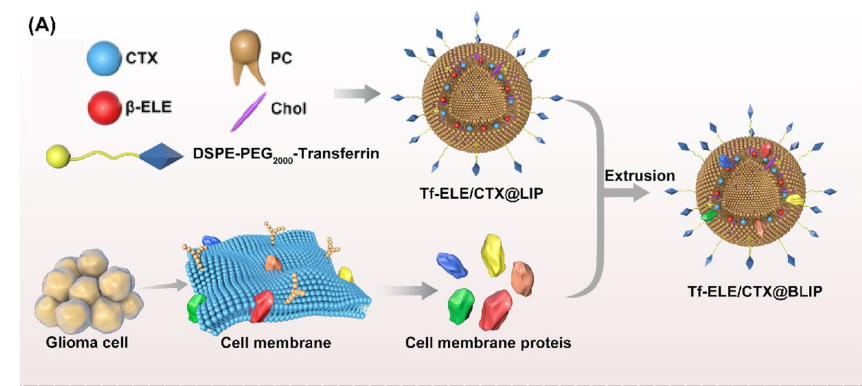文献:Active targeting of orthotopic glioma using biomimetic liposomes co-loaded elemene and cabazitaxel modified by transferritin.
文献链接:
https://xueshu.baidu.com/usercenter/paper/show?paperid=1c6q04m0fa0c0xv045550jt0fm178021&site=xueshu_se
作者:Jie Li, Huamin Zeng, Yu You, Rongrong Wang, Tiantian Tan, Weiming Wang, Liyan Yin ,Zhaowu Zeng, Yiying Zeng and Tian Xie
相关产品:DSPE-PEG2000-TF 磷脂-聚乙二醇2000-转铁蛋白
原文摘要:Background: Efective treatment of glioma requires a nanocarrier that can cross the blood–brain barrier (BBB) to target the tumor lesion. In the current study, elemene (ELE) and cabazitaxel (CTX) liposomes were prepared by conjugating liposomes with transferrin (Tf ) and embedding the cell membrane proteins of RG2 glioma cells into liposomes (active-targeting biomimetic liposomes, Tf-ELE/CTX@BLIP), which exhibited efective BBB infltration to target glioma.
Results: The fndings showed that Tf-ELE/CTX@BLIP was highly stable. The liposomes exhibited highly signifcant homologous targeting and immune evasion in vitro and a 5.83-fold intake rate compared with classical liposome (ELE/CTX@LIP). Bioluminescence imaging showed increased drug accumulation in the brain and increased tumor penetration of Tf-ELE/CTX@BLIP in orthotopic glioma model nude mice. Findings from in vivo studies indicated that the antitumor efect of the Tf-ELE/CTX@BLIP led to increased survival time and decreased tumor volume in mice. The average tumor fuorescence intensity after intravenous administration of Tf-ELE/CTX@BLIP was 65.2, 12.5, 22.1, 6.6, 2.6, 1.5 times less compared with that of the control, CTX solution, ELE solution, ELE/CTX@LIP, ELE/CTX@BLIP, Tf-ELE/ CTX@LIP groups, respectively. Histopathological analysis showed that Tf-ELE/CTX@BLIP were less toxic compared with administration of the CTX solution.
Conclusion: These fndings indicate that the active-targeting biomimetic liposome,Tf-ELE/CTX@BLIP, is a promising nanoplatform for delivery of drugs to gliomas.
DSPE-PEG2000-转铁蛋白是由亲水性的聚乙二醇(PEG2000)与疏水性的二硬脂酰磷脂酰乙醇胺(DSPE)相连。其中,DSPE可与脂质成分相互作用,PEG2000则保证材料在水性环境中的稳定性和良好的生物相容性,延长在体内的循环时间。转铁蛋白作为一种内源性的蛋白质,能够特异性地识别并结合某些细胞表面的转铁蛋白受体,这种受体在特定细胞类型中往往高表达。该材料可用于构建智能化合物递送系统。它能够将化合物装载在其内部或与之结合,通过转铁蛋白与靶细胞表面受体的相互作用,实现化合物的靶向递送,增强。该文献通过将脂质体与转铁蛋白(Tf)结合,将RG2 Glioma细胞的细胞膜蛋白包入脂质体(活性靶向仿生脂质体,Tf-ELE/CTX@BLIP),制备了硒(ELE)和卡巴他醇(CTX)脂质体。过程如下:

图:靶向仿生脂质体(Tf-ELE/CTX@BLIP)的制备
Tf-ELE/CTX@BLIP的制备
采用高速剪切法结合探针超声法制备了AELE/CTX@LIP和Tf-ELE/CTX@LIP的活性靶向仿生脂质体的合成工艺。为了制备Tf-ELE/ CTX@LIP:将 CTX在超声浴下溶解在乙醇中。然后在溶液中加入ELE胆固醇、大豆卵磷脂、TPGS、DSPE-PEG2000-转铁蛋白和MCT。Te混合物在水浴下加热溶解形成油相。另外,将甘油溶解在水中,剪切,生成水相。将Te油相缓慢注入水相中,剪切。然后使用超声超声仪减小。基于cmp的脂质体通过直接挤压方法产生。Tf-ELE/CTX@BLIP是基于Tf-ELE/CTX@LIP。综上所述,CMP与Tf-ELE/CTX@LIP或ELE/CTX@LIP混合,磷脂与CMP以一定重量比。将Te混合物直接通过孔隙挤压,生成Tf-ELE/CTX@ BLIP和ELE/CTX@BLIP。

图;仿生脂质体粒子大小
结论:DSPE-PEG2000-转铁蛋白参与制备的Tf-ELE/CTX@BLIP具有高度的稳定性。与经典脂质体(ELE/CTX@LIP)相比,脂质体在体外表现出高度的同源靶向性和免疫逃避性,摄入率为5.83倍。生物发光成像显示,Tf-ELE/CTX@BLIP在化合物积累增加。体内研究结果表明,Tf-ELE/CTX@BLIP的抗tumor作用可增加小鼠的生存时间,减少tumor体积。

 2025-02-17 作者:ZJ 来源:
2025-02-17 作者:ZJ 来源:

